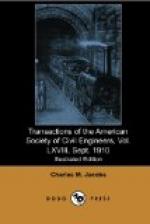Second.—As much room
as possible at the elevation of the top of
rail;
Third.—The least necessary
interference with adjoining property
during construction; and,
Fourth.—The most economical
wall that would fulfill the other
conditions.
As stated in the paper by Alfred Noble, Past-President, Am. Soc. C. E., the third stipulation required the relinquishing of a portion of the space under these streets granted by the City, but it was finally decided not to approach the south house line of 31st Street with the back of the walls nearer than 9 ft., while on 33d Street the extreme position of the back was fixed at the north line, as there were no buildings, except those belonging to the Railroad Company, on the house line at the low points in the rock.
The assumptions made in designing the wall were as follows:
First.—Weight of concrete, 140 lb. per cu. ft.
Second.—Weight of material
from the surface of the ground to a
depth of 12 ft. (which was
shown by tests made in bore-holes to be
the elevation of the ground-water
surface), 100 lb. per cu. ft.;
and angle of repose, 30 degrees.
The distance of 12 ft. below
the surface was the depth
of the inverts of the sewers, which
undoubtedly drained the ground
above them, thus accounting for the
standing of the ground-water
in planes practically parallel with
the surface.
Third.—Weight of buildings
back of wall neglected, as that of the
present type will about equal
the cellars filled with material at
100 lb. per cu. ft., and if
large buildings are erected in the
future they will undoubtedly
be carried to rock.
Fourth.—Reaction from
superstructure, live and dead load, 20,000
lb. per lin. ft. of wall.
Fifth.—Weight of materials
below the 12-ft. line, 124 lb. per
cu. ft., ascertained as follows:
The material was considered as
weighing 165 lb. per cu. ft.
in the solid, and having 40% of voids
filled with water at 62.5
lb. per cu. ft., the resulting weight
being (165 x 60/100) + (62.5
x 40/100) = 124 lb. per cu. ft.
Various angles of repose were used for this material in the investigation, and it was finally decided that 30 deg. was the greatest angle that could be expected, whereas the worst condition that could be anticipated was that the sand and water would act separately and give a pressure as follows:
Hydraulic pressure from liquid weighing 62.5 lb. per cu. ft. plus pressure from sand with angle of repose at 30 deg. and weight as follows:
Weight of 1 cu. ft. in air = 165 x 60/100 = 99 lb.
Weight of water displaced by 1 cu. ft. = 60/100 x 62.5 lb. = 37.5 lb.
Weight in water, therefore = 61.5 lb. per cu. ft.
These combined weights, of course, are equal to the weight of the combined material in the previous assumption.




